
A cruiser is a type of warship. Modern cruisers are generally the largest ships in a fleet after aircraft carriers and amphibious assault ships, and can usually perform several operational roles from search-and-destroy to ocean escort to sea denial.
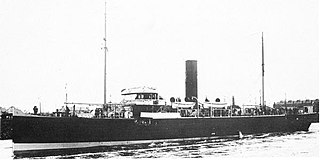
Q-ships, also known as Q-boats, decoy vessels, special service ships, or mystery ships, were heavily armed merchant ships with concealed weaponry, designed to lure submarines into making surface attacks. This gave Q-ships the chance to open fire and sink them.

The German auxiliary cruiser Atlantis, known to the Kriegsmarine as Schiff 16 and to the Royal Navy as Raider-C, was a converted German Hilfskreuzer, or merchant or commerce raider of the Kriegsmarine, which, in World War II, travelled more than 161,000 km (100,000 mi) in 602 days, and sank or captured 22 ships with a combined tonnage of 144,384. Atlantis was commanded by Kapitän zur See Bernhard Rogge, who received the Oak Leaves to the Knight's Cross of the Iron Cross. She was sunk on 22 November 1941 by the British cruiser HMS Devonshire.

An armed merchantman is a merchant ship equipped with guns, usually for defensive purposes, either by design or after the fact. In the days of sail, piracy and privateers, many merchantmen would be routinely armed, especially those engaging in long distance and high value trade.

A warship or combatant ship is a ship that is built and primarily intended for naval warfare. Usually they belong to the armed forces of a nation. As well as being armed, warships are designed to withstand damage and are typically faster and more maneuverable than merchant ships. Unlike a merchant ship, which carries cargo, a warship typically carries only weapons, ammunition and supplies for its crew. Warships usually belong to a navy, though they have also been operated by individuals, cooperatives and corporations.

The Town-class destroyers were a group of 50 destroyers of the Royal Navy and the Royal Canadian Navy that were in service during the Second World War. They were transferred from the United States Navy in exchange for military bases in the British West Indies and Newfoundland, as outlined in the Destroyers for Bases Agreement between the United Kingdom and United States, signed on 2 September 1940. They were known as "four-pipers" or "four-stackers" because they had four smokestacks (funnels). Later classes of destroyers typically had one or two.

HMNZS Leander was a light cruiser which served with the Royal New Zealand Navy during World War II. She was the lead ship of a class of light ships, the Leander-class light cruiser and was initially named HMS Leander.

HMAS Kanimbla was a passenger ship converted for use as an armed merchant cruiser and landing ship infantry during World War II. Built during the mid-1930s as the passenger liner MV Kanimbla for McIlwraith, McEacharn & Co, the ship operated in Australian waters until 1939, when she was requisitioned for military service, converted into an armed merchant cruiser, and commissioned in the Royal Navy as HMS Kanimbla.
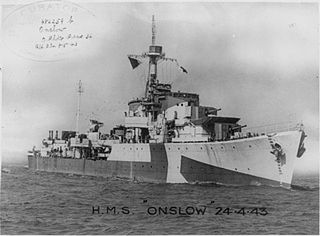
HMS Onslow was an O-class destroyer of the Royal Navy. The O-class were intermediate destroyers, designed before the outbreak of the Second World War to meet likely demands for large number of destroyers. They had a main gun armament of four 4.7 in guns, and had a design speed of 36 kn. Onslow was ordered on 2 October 1939 and was built by John Brown & Company at their Clydebank, Glasgow shipyard, launching on 31 March 1941 and completing on 8 October 1941.
Vorpostenboot, also referred to as VP-Boats, flakships or outpost boats, were German patrol boats which served during both World Wars. They were used around coastal areas and in coastal operations, and were tasked with – among other things – coastal patrol, ship escort, and naval combat.

Naval trawlers are vessels built along the lines of a fishing trawler but fitted out for naval purposes; they were widely used during the First and Second World Wars. Some—known in the Royal Navy as "Admiralty trawlers"— were purpose-built to naval specifications, others adapted from civilian use. Fishing trawlers were particularly suited for many naval requirements because they were robust vessels designed to work heavy trawls in all types of weather, and had large clear working decks. A minesweeper could be created by replacing the trawl with a mine sweep. Adding depth charge racks on the deck, ASDIC sonar below, and a 3-inch (76 mm) or 4-inch (102 mm) gun in the bow equipped the trawler for anti-submarine duties.
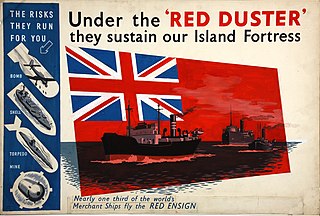
Defensively equipped merchant ship (DEMS) was an Admiralty Trade Division programme established in June 1939, to arm 5,500 British merchant ships with an adequate defence against enemy submarines and aircraft. The acronym DEMS was used to describe the ships carrying the guns, the guns aboard the ships, the military personnel manning the guns, and the shore establishment supporting the system.

The Action of 16 March 1917 was a naval engagement in which the British armed boarding steamer SS Dundee and HMS Achilles, a Warrior-class armoured cruiser, fought the German auxiliary cruiser SMS Leopard, which sank with the loss of all 319 hands and six men of a British boarding party.
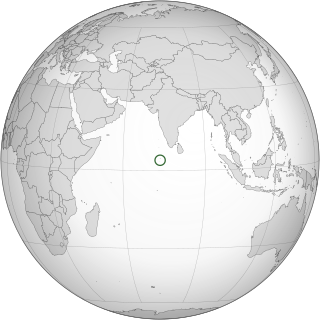
The Action of 27 February 1941 was a single ship action between the British cruiser HMS Leander and the Italian ship Ramb I an auxiliary cruiser. It began when Leander ordered an un-flagged freighter to stop for an inspection. The freighter raised the Italian colours and engaged Leander which sank Ramb I shortly after. About 150 members of the crew were killed and 100 were rescued and taken to Addu Atoll, thence to Ceylon. Leander patrolled southwards to investigate more reports of commerce raiders.

SMS Leopard was a British cargo steamship that was built in 1912 as Yarrowdale, captured in 1916 by the Imperial German Navy, converted into a commerce raider in Germany, and sunk with all hands by the Royal Navy in 1917.

TSS (RMS) King Orry (III) – the third ship in the history of the Company to bear the name – was a passenger steamer which served with the Isle of Man Steam Packet Company, until she was sunk in the evacuation of Dunkirk in 1940.

SMS Meteor was an auxiliary cruiser of the Imperial German Navy which operated against Allied shipping during World War I.
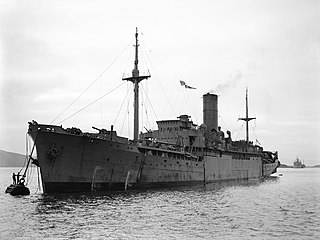
HMS Agamemnon was originally the Blue Funnel Line refrigerated cargo ship Agamemnon. She was built in 1929, traded between the UK and the Far East, and was scrapped in 1963. During the Second World War she was converted into an auxiliary minelayer in 1940, and then into an amenities ship in 1943.
This glossary defines the various types of ships and accessory watercraft that have been used in service of the United States. Such service is mainly defined as military vessels used in the United States Navy and United States Coast Guard, as well as the defunct, incorporated, or renamed institutions such as the United States Revenue Cutter Service. Service of the United States can also be defined in this context as special government missions in the form of expeditions, such as the Wilkes Expedition or the North Pacific Exploring and Surveying Expedition. The scope of the glossary encompasses both the "Old Navy" of the United States, from its beginnings as the "Continental Navy", through the "New Navy" and up to modern day. The watercraft included in the glossary are derived from United States ships with logbooks published by the National Archives and Records Administration.